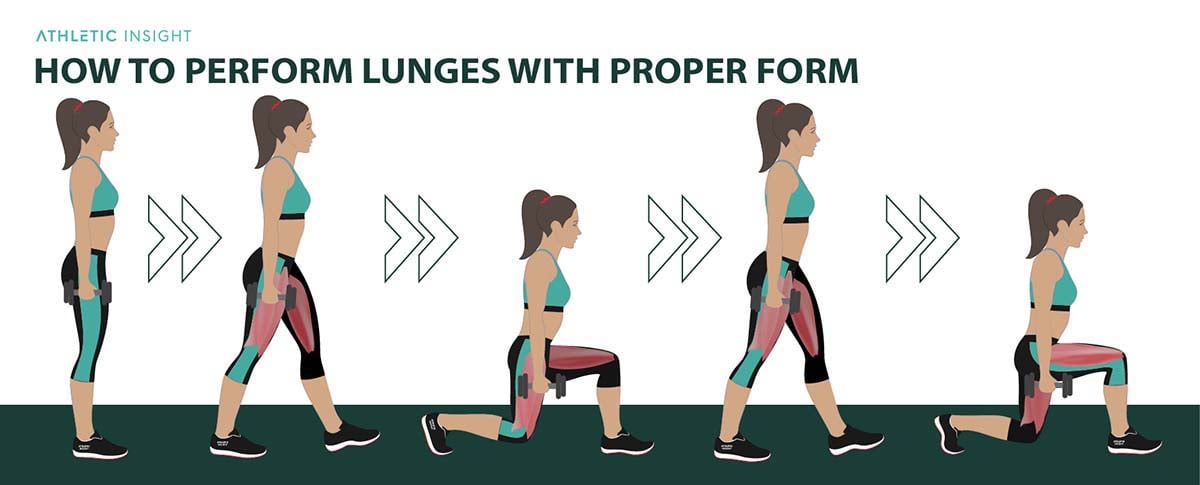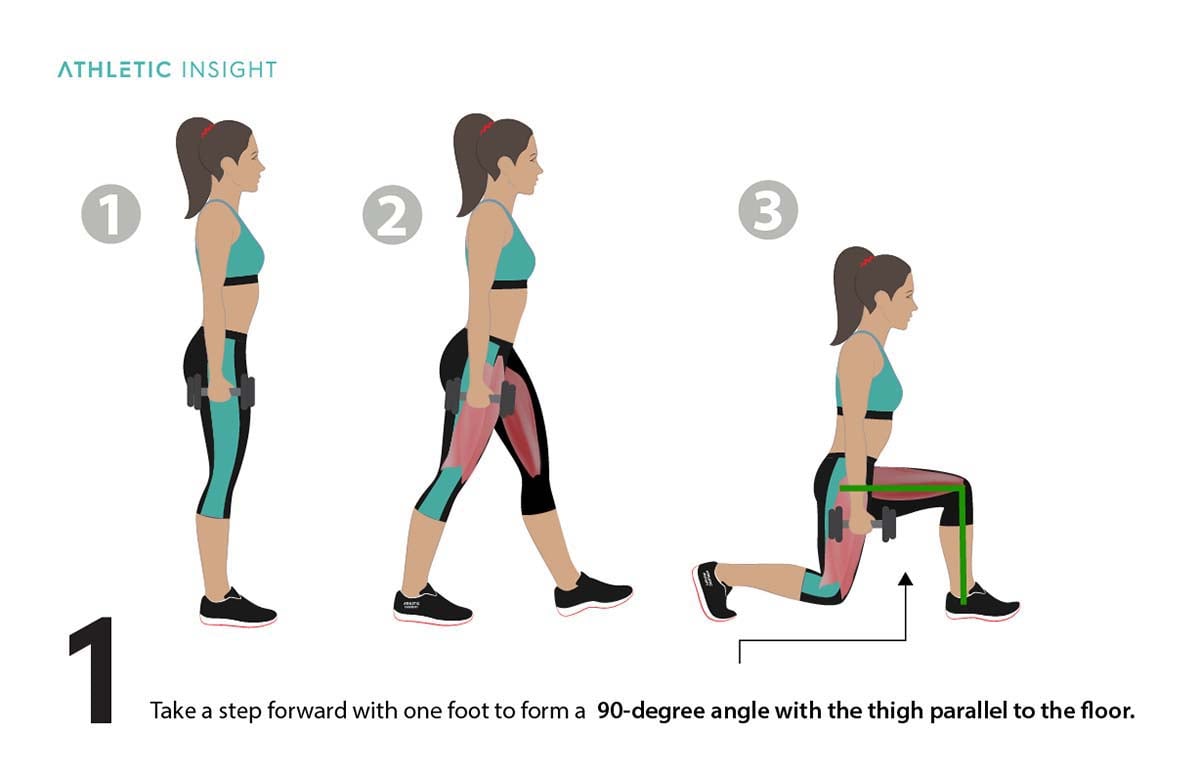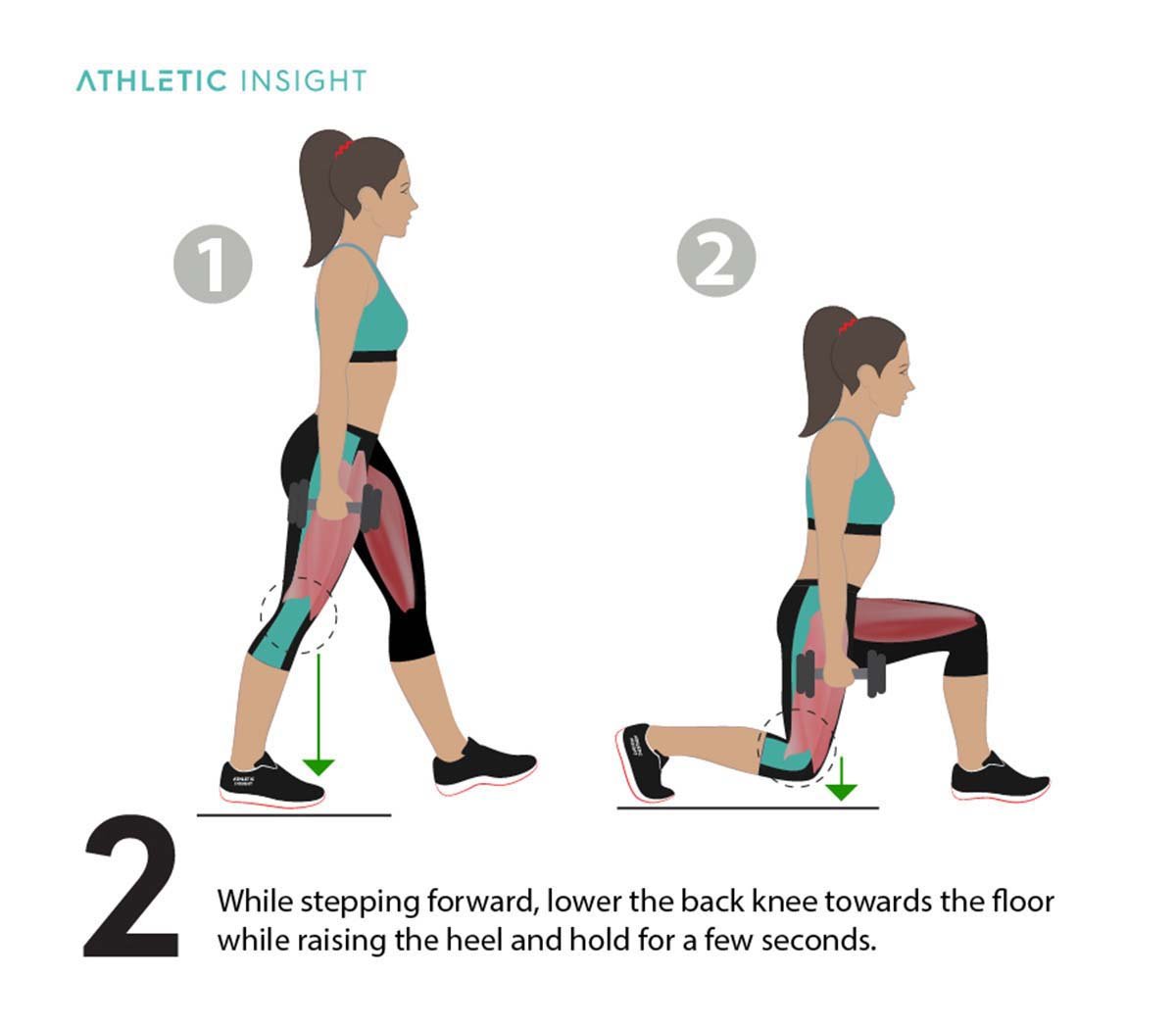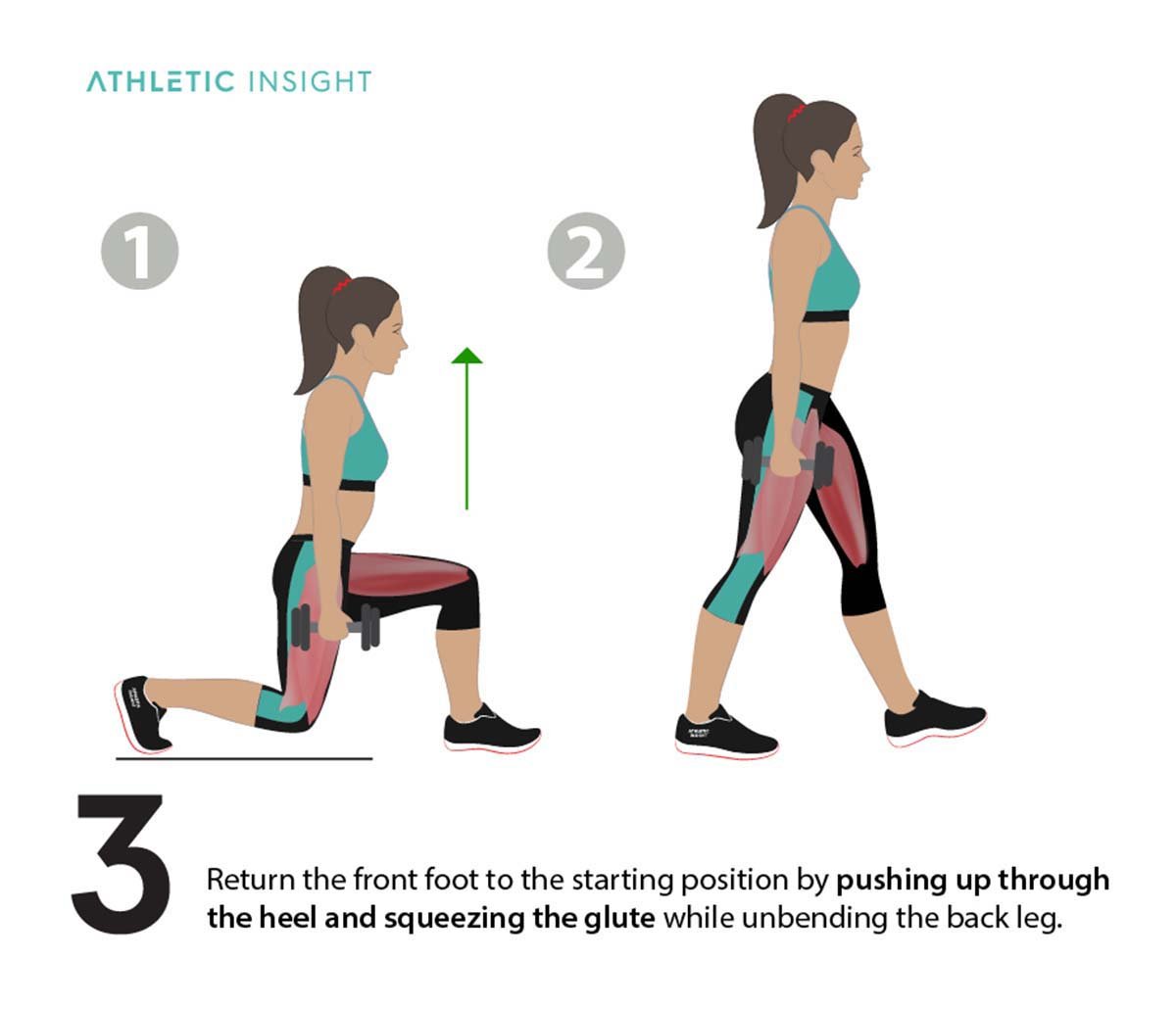A lunge is a compound, lower-body exercise that strengthens the glutes and thighs, engages the core muscles, aids in weight loss, and improves hip flexibility. To perform a lunge, you step forward with one foot so that the knee is bent at a 90-degree angle, and the supporting back leg is bent with the heel elevated and the knee towards the ground.
A proper lunge form is important to avoid injury. The front thigh should be parallel to the floor, and the knee of the front leg should not extend beyond the toes. When performed properly, lunges are great exercises for strength and balance. Common mistakes include looking down and neglecting to engage core muscles. Mistakes can lead to injuries and cause patellofemoral pain in the knees.
There are more than 40 lunge variations that target different areas of the glutes and legs. Some common lunges are stationary, reverse, walking, lateral, jump, and curtsy.
How to Perform Lunges with Proper Form
The basic instructions to perform a standard static lunge are as follows.

- Take a step forward with one foot
- Lower the back knee towards the floor
- Return the front foot to the starting position
Now that you have the basic steps of this leg exercise, it’s important to consider not only the position of your legs and feet, but of your entire body.
1. Take a step forward with one foot
Take a step forward with one foot to form a 90-degree angle with the thigh parallel to the floor.

2. Lower the back knee towards the floor
While stepping forward, lower the back knee towards the floor while raising the heel and hold for a few seconds.

3. Return the front foot to the starting position
Return the front foot to the starting position by pushing up through the heel and squeezing the glute while unbending the back leg.

What Are the Benefits of Lunges?
Here are 6 important benefits of incorporating lunges into your workout regimen.
- Helps with weight loss.
- Improves balance and stability.
- Corrects imbalances and alignment of your body.
- Improves posture.
- Increases leg muscle mass.
- Increases leg strength.

By performing 2 to 3 sets of 12 reps per session on each leg 3 times per week, you will begin to experience the benefits of lunges. Adding weights to your lunges increases the benefits.
1. Helps with Weight Loss
Lunges aid in weight loss by building muscle mass and reducing body fat. This increases your metabolism. Lunges also build strength to improve aerobic activity and endurance for increased weight loss.
2. Improves Balance and Stability
Lunges combine balancing on one foot with core muscle engagement by working the legs, glutes, abdominals, and back muscles.
3. Corrects Imbalances and Alignment of Your Body
As a unilateral exercise or one that uses one leg at a time, lunges work both the dominant and weaker sides to help with strength imbalances. This, in turn, helps body alignment and strength balance.
4. Improves Posture
Lunges will improve posture by working your core abdominal and lower back muscles to support your torso and head in proper alignment.
5. Increases Leg Muscle Mass
Doing lunges works leg muscles, including the quadriceps, hamstring, and calves. Adding weights to your moves more rapidly builds leg muscle mass.
6. Increases Leg Strength
With lunges working so many leg muscles, you will notice an increase in your leg strength when you perform them regularly.
What Are the Mistakes for Lunge Exercise Form?
Some common lunges mistakes when performing lunges are as follows.
- Extending the knee beyond the toes on the front leg.
- Looking down instead of straight ahead.
- Neglecting to engage the core abdominal muscles.
- Leaving the back foot flat on the floor.
- Slamming the knee onto the floor.
- Leaning back when using weights.
How to Determine Proper Weight for Lunges?
When adding weights to your lunges, it’s important to understand how much weight you should be lifting to avoid strains and injury.
Use the following formula to calculate your 1RM:
1RM = Weight Lifted × ( 1 + ( 0.033 × Number of repetitions ) )
For example, if you lift 15 pounds for 10 repetitions, your 1RM would be 20.
Which Muscles are Involved While Performing Lunges?
The main muscles engaged are the gluteus maximus, hamstrings, quadriceps, gastrocnemius/soleus, transverse abdominis, obliques, multifidus, and the erector spinae. Each muscle benefits in different ways.
- Gluteus Maximus (buttocks): Lunges tone and increase the size of the glutes.
- Hamstrings (back of thigh): Lunges strengthen the hamstrings for better knee stability.
- Quadriceps (front of thigh): Lunges tone and increase the size of the quads.
- Gastrocnemius/Soleus (calves): Lunges don’t target the calves but do provide a solid calf workout.
- Transverse Abdominis/Obliques (abs): Improves stability, balance, and posture.
- Multifidus/Erector Spinae (back): Decreases lower back pain and improves balance and posture.
What Are the Phases of Lunges?
Lunges phases are as follows.
- Eccentric phase: involves hip and knee flexion and ankle dorsiflexion.
- Isometric phase: the momentary holding of the position.
- Concentric phase: consists of hip, knee, lumbar spine extension, and ankle plantarflexion.
What are the Lunges Challenges?
Take inspiration from some of the more popular challenges to add this exercise to your routine.
1. Easy 31 Day Lunge Challenge
Start with four basic lunges per leg on day 1, and progress by adding six different variations and building the reps to 16 jump lunges per leg on day 31.
2. 100 Rep Lunge Challenge
The basics:
- 10 Different kinds of lunges
- 10 Reps each
- No Equipment
- 3-4 times per week
3. 30 Day Lunge Challenge
Every day for 30 days, do 100 lunges and as many switch lunges as possible.
The basics are as follows.
- 30 Forward Lunges (15 each leg)
- 20 Right Side Lunges
- 20 Left Side Lunges
- 30 Reverse Lunges (15 each leg)
- Switch Lunges: as many as possible
You can spread your lounge exercises throughout the day. At least once weekly, do all 100 at once.
What Are the Lunges Variations?
Lunge variations target different areas as you work out. The following is a list of 18 common variations of lunge with basic movements.

1. Bodyweight Forward Lunge
This one is the basic lunge form: without additional weights.
2. Bodyweight Reverse Lunge
A reverse lunge requires stepping backward rather than forward. The ending position is the same as a forward lunge. You simply step back to get there and forward to return to the starting position.
3. Dumbbell Forward Lunge
Stand with weights in each hand hanging down by your sides. Keep the weights in place as you perform a basic forward lunge.
4. Dumbbell Reverse Lunge
Stand with weights in each hand hanging down by your sides. Keep the weights in place as you perform a basic reverse lunge.
5. Bodyweight Lateral Lunge
Begin with a standard lunge and swing your hands out in front of you for balance, tighten your abs, and take a big step to one side. Shift your weight into the stepping leg as you bend your knee and send your hips back.
Come down into a squat position with the knee at 90 degrees, extending the opposite leg out straight. You will need to lean forward at the hip while keeping your torso long. Push through the foot in the bent leg to return to starting position.
6. Curtsy Lunge
Put your weight into your stationary foot and step back and around with your other foot, much like a curtsy, until your thigh is parallel to the ground. Bring your arms in front of you while keeping your torso upright and chest open.
Straighten your standing leg by pushing up through the heel while returning your other foot to starting position.
7. Reverse Lunge With Rotation
Begin as with a basic reverse lunge, with a weight such as a dumbbell or medicine ball held directly in front of the chest with elbows close to the rib cage and back straight.
Perform the reverse lunge and turn toward the stationary leg at the bottom of the movement. Turn back to center before returning to the starting position.
8. Lunge Jump
Start in a basic lunge position with one leg bent in front and the other behind. From that point, push your front foot into the ground while swinging your arms forward to jump and switch the position of your feet. Keep switching legs for the desired number of reps.
9. Dumbbell Lateral Lunge
Hold the dumbbells at your sides with palms facing inward. Keep the arms hanging straight down as you lunge to the side.
10. Single-Leg Deadlift to Reverse Lunge
Perform a single-leg deadlift. Return to starting position to do a reverse lunge with the same leg.
11. Curtsy Lunge with Kick
Go into a curtsy lunge. Kick the lunging leg up and out to the side before returning to the curtsy lunge. This kick will add some cardio to your lunge movement.
12. Alternating Forward to Reverse Lunge
Begin with a basic forward lunge. Rather than returning the lunging leg to the start position, take it to a reverse lunge.
13. 5 O’Clock Lunge
When stepping out, rotate away from your body toward the 5-o’clock position. Keep your left leg straight as you bend your lunging knee and push your hips back to lower into a lateral lunge.
14. Reverse Lunge to Overhead Press With Knee Drive
Hold a dumbbell in the hand of the lunging leg straight up in the air. Bend your elbow to bring the dumbbell to shoulder height as you step back into the reverse lunge. Push the weight back up in the air as you return your leg to the start position.
15. Lateral Lunge Into Runners Jump
Step out for a lateral lunge. When pulling the lunging leg back in, pull the knee to the chest and jump on the standing foot. Go straight back into another lateral lunge.
16. Resistance Band Lateral Lunge
Place a resistance band around your ankles while performing the movement.
17. Step-up to Reverse Lunge
Use a step to step up onto one foot at a time. With the trailing foot, take a step back down and bring the other foot into a reverse lunge. Use the lunging foot to step back onto the box and repeat.
18. Explosive Sprinters Lunge
Step back into a reverse lunge. When bringing the lunging foot back to the start position, keep the knee bent and jump on the standing leg. Go straight back to another reverse lunge.
What Are the Necessary Pieces of Equipment for Lunges?
The great thing about lunges is that you don’t need any equipment to perform them. Once you master the basic move, you can add equipment such as the following to enhance the exercise.

- Dumbbells
- Barbells
- Kettlebells
- Resistance bands.
What Are the World Records for Lunges?
Guinness World Records features several lunge records. You must be 16 or older to apply to break a record.
Lunge Record Categories
Categories for lunge records include the following.
- Fastest lunge mile
- Most backward lunges in 30 seconds
- Most lunges in one minute
- Most backward lunges in one minute
- Most reverse lunges on a sliding disc in one minute
- Fastest time to lunge is 20 m
- Most lunges in one minute carrying a 20 lb pack
Women Lunges Records
- Fastest lunge mile: 31 min 51 sec,11/16/13, Irene Call
- Most lunges in one minute: 80, 7/25/19, Sandra Hickson
Men Lunges Records
- Fastest lunge mile: 25 min 21.11 sec, 8/7/2010, Jamasen Rodriguez
- Most lunges in one minute: 75, 8/13/20, Christian Roberto López Rodríguez.
What Is the Origin of Lunges?
Asian martial arts training includes an early known lunge form. The lunge name derives from fencing footwork techniques. The lunge is a short form of the French word “allonger”, which means to extend or thrust.
Which Muscles Can Be Affected More From Lunges?
Lunges involve the glutes, quads, hamstrings, calves, abdominals, and lower back muscles.
What are the back muscle exercises with Lunges?
Lunges work the multifidus and erector spinae muscles of the back. Adding lunges to your workout decreases lower back pain and improves balance and posture.
What are the leg muscle exercises for the Lunges?
The quads, hamstrings, and calves are strengthened, toned, and increased in size when this exercise is performed regularly.
What Is the Effectiveness of Lunges for Muscle Growth When Compared to Squat?
Lunges are optimal for defining and shaping the legs and glutes. Squats are a better choice to increase muscle mass.
What Are the Lunge Exercise Related Facts?
This exercise is a great way to work lower body and core muscles to increase strength, stability, balance, and posture. Lunge variations work muscles differently, and adding weights increases resistance.
Do Lunges affect the hormones?
Hormones levels are affected by exercise. Performing lunges three times weekly helps balance epinephrine/norepinephrine, insulin, cortisol, estrogen, testosterone, progesterone, and serotonin.
Do Lunges Increase Testosterone?
While all exercise increases testosterone, lower body multi-joint exercises such as lunges have a bigger impact on this hormone.
Do Lunges affect the heart rate?
Lunges elevate the heart rate. Heart rate increases depending on the type of lunge and the pacing. Jumping and sprinters lunges are good variations to increase heart rate.
Are Lunges practiced within Crossfit?
Crossfit is a mixed modal training including different types of activities within one workout. Lunges are used in Crossfit as a strength training move.
Are Lunges a military movement?
Lunges are used in military conditioning. They are included in the US Army’s Pocket Physical Training Guide.
Are Lunges dangerous?
No, lunges are not dangerous. When performed correctly, this exercise is very safe.
Are Lunges push or pull?
Lunges are considered push exercises when performing a push-pull strength training routine.
Are Lunges essential?
Lunges are an important part of a lower-body strength-training regimen that also helps prevent injury.
Are Lunges an Olympic lift?
Lunges are a key exercise to strengthen the legs for Olympic-style weightlifting moves such as snatches, cleans, and jerks.
What is the difference between lunges and squats?
Lunges involve stepping forward and bending the knee at a 90-degree angle. Squats are performed with both feet planted while lowering the hips as though sitting in a chair.
Lunges and squats work the quads, calves, hamstrings, glutes, and lower back. They aid in weight loss and strengthen the knee joints. The biggest difference is that squats are easier for beginners because they require less balance.
The biggest downside to both of these moves is the potential for a knee injury. Proper form is key to preventing knee problems.
How many calories can lunges burn?
One 3-second basic lunge burns approximately .3 calories on average. In 1 minute, you will burn 6 calories. Calorie burn varies with the lunge variation performed.
Are lunges knee friendly?
Lunges are knee-friendly if performed correctly. People with knee problems can modify lunges by going only a quarter of the way down, shortening the lunge stride, or doing reverse lunges.



